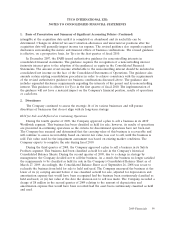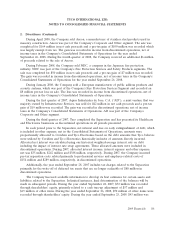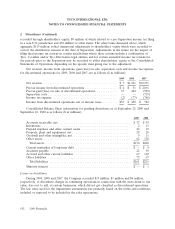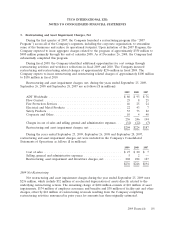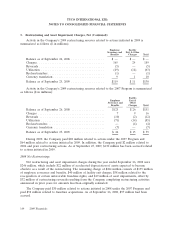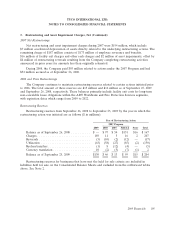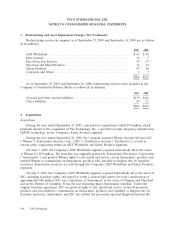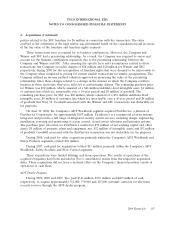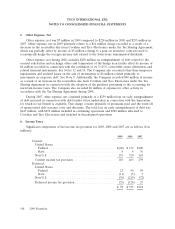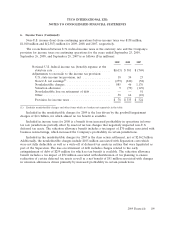ADT 2009 Annual Report Download - page 191
Download and view the complete annual report
Please find page 191 of the 2009 ADT annual report below. You can navigate through the pages in the report by either clicking on the pages listed below, or by using the keyword search tool below to find specific information within the annual report.TYCO INTERNATIONAL LTD.
NOTES TO CONSOLIDATED FINANCIAL STATEMENTS
1. Basis of Presentation and Summary of Significant Accounting Policies (Continued)
intangible at the acquisition date until it is completed or abandoned and its useful life can be
determined. Changes in deferred tax asset valuation allowances and uncertain tax positions after the
acquisition date will generally impact income tax expense. The revised guidance also expands required
disclosures surrounding the nature and financial effects of business combinations. The revised guidance
is effective, on a prospective basis, for Tyco in the first quarter of fiscal 2010.
In December 2007, the FASB issued authoritative guidance for noncontrolling interests in
consolidated financial statements. The guidance requires the recognition of a noncontrolling interest
(minority interest prior to the adoption of the guidance) as equity in the Consolidated Financial
Statements. The amount of net income attributable to the noncontrolling interest should be included in
consolidated net income on the face of the Consolidated Statements of Operations. The guidance also
amends certain existing consolidation procedures in order to achieve consistency with the requirements
of the revised authoritative guidance for business combinations discussed above. The guidance also
includes expanded disclosure requirements regarding the interests of the parent and its noncontrolling
interest. This guidance is effective for Tyco in the first quarter of fiscal 2010. The implementation of
the guidance will not have a material impact on the Company’s financial position, results of operations
or cash flows.
2. Divestitures
The Company continued to assess the strategic fit of its various businesses and will pursue
divestiture of businesses that do not align with its long-term strategy.
Held for Sale and Reflected as Continuing Operations
During the fourth quarter of 2009, the Company approved a plan to sell a business in its ADT
Worldwide segment. This business has been classified as held for sale; however, its results of operations
are presented in continuing operations as the criteria for discontinued operations have not been met.
The Company has assessed and determined that the carrying value of this business is recoverable and
will continue to assess recoverability based on current fair value, less cost to sell, until the business is
sold. Fair value used for the impairment assessment was based on existing market conditions. The
Company expects to complete the sale during fiscal 2010.
During the third quarter of 2008, the Company approved a plan to sell a business in its Safety
Products segment. This business had been classified as held for sale in the Company’s historical
Consolidated Balance Sheets. During the second quarter of 2009, due to a change in strategy by
management, the Company decided not to sell the business. As a result, the business no longer satisfied
the requirements to be classified as held for sale in the Company’s Consolidated Balance Sheet as of
March 27, 2009. Accordingly, the Consolidated Balance Sheet as of September 26, 2008 was recast to
reclassify the business from held for sale to held and used. The Company measured the business at the
lower of its (i) carrying amount before it was classified as held for sale, adjusted for depreciation and
amortization expense that would have been recognized had the business been continuously classified as
held and used, or (ii) fair value at the date the decision not to sell was made. The Company recorded a
charge of $8 million in the second quarter of 2009 relating to the amount of depreciation and
amortization expense that would have been recorded had the asset been continuously classified as held
and used.
2009 Financials 99












